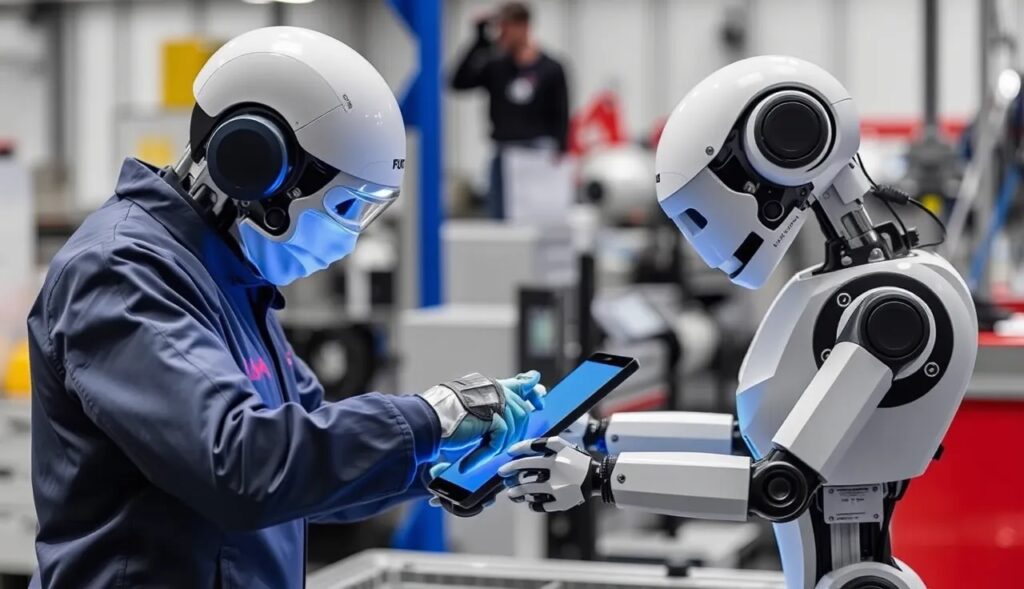
As collaborative robots (cobots) take over repetitive and hazardous tasks, building trust between humans and machines is more crucial than ever. Trust ensures cobots become reliable teammates, not just high-tech tools.
Let’s explore the psychology behind trust in automation and how it drives the adoption of cobots.
Why Trust Matters in Human-Cobot Collaboration
Trust Affects Performance and Safety
When humans trust cobots, they work more efficiently and with less hesitation. Trust reduces overcompensation, like double-checking cobots’ actions, which can slow production.
On the flip side, distrust leads to risky behavior, such as bypassing cobot safety protocols. This can result in accidents, harming both employees and workflows.
Emotional Connection Builds Confidence
Trust isn’t just about data; emotions play a big role. Feeling secure around cobots boosts confidence in their reliability. Humans need to feel like they’re working with a “partner” rather than an unpredictable machine.
Misalignment in Expectations Hurts Adoption
A mismatch between what a cobot can do and what humans expect can erode trust. If a cobot fails to meet its promised performance, trust takes a hit—even if the error rate is minimal.
How Transparency Enhances Trust in Automation
Clear Communication of Capabilities
When cobots communicate their actions and limitations effectively, humans feel more in control. Simple interfaces and real-time feedback bridge this gap.
For example, a cobot showing visual cues (like LED lights) for task completion makes its actions more predictable, fostering trust.
Predictable and Consistent Behavior
Consistency is key. Cobots that behave predictably reduce cognitive strain on workers. Erratic or unexplained actions lead to skepticism, even when there’s no real danger.
Pro tip: Regular calibration and software updates keep cobots running smoothly, ensuring reliability over time.
Explainable AI: Breaking the “Black Box”
People are more likely to trust what they understand. Explainable AI allows cobots to share the reasoning behind their decisions, making their actions feel less mysterious.
Imagine a cobot explaining why it stopped during a quality check. That small gesture can build immense trust.
Designing Cobots with Psychological Safety in Mind
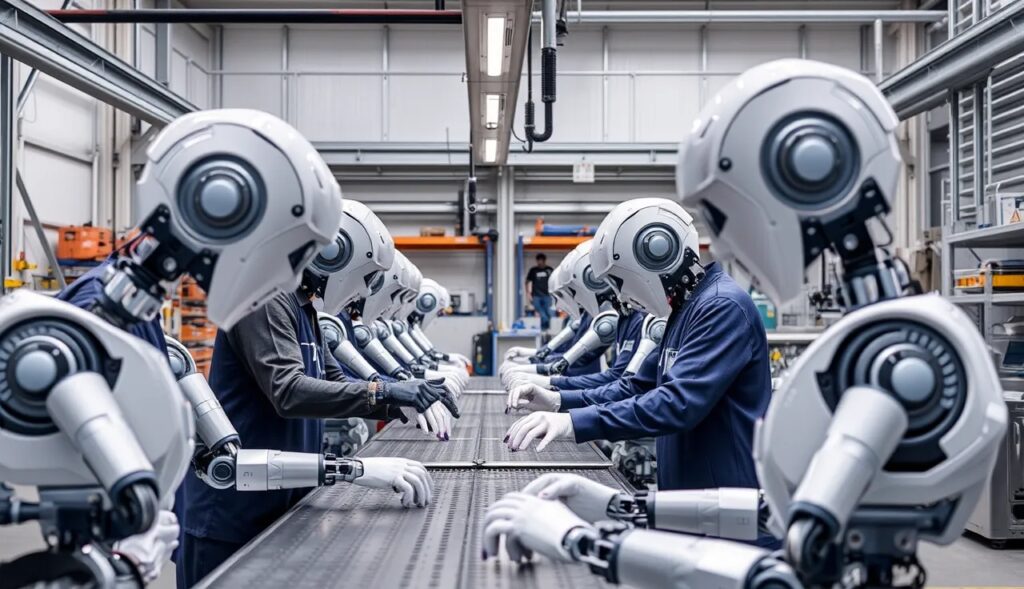
Friendly and Intuitive Design
Cobots with a human-friendly appearance (soft edges, neutral colors) appear less intimidating. Intuitive controls and user interfaces reduce the learning curve.
Adaptive Behavior for Different Skill Levels
Smart cobots adapt to the experience level of their users. For instance, beginners may require more guidance, while advanced operators benefit from a streamlined workflow.
Demonstrated Reliability Under Pressure
When cobots perform well in challenging scenarios, it solidifies trust. Think of cobots that continue precise welding during system stress. Real-life demonstrations can make a big impression.
The Role of Social Proof in Boosting Confidence
Positive Peer Experiences
Workers are more likely to trust cobots if their colleagues share positive experiences. Case studies and testimonials amplify this effect.
Industry Benchmarks as Assurance
When cobots achieve high ratings for reliability and safety, it reassures skeptical workers. Industry certifications and awards can also bolster credibility.
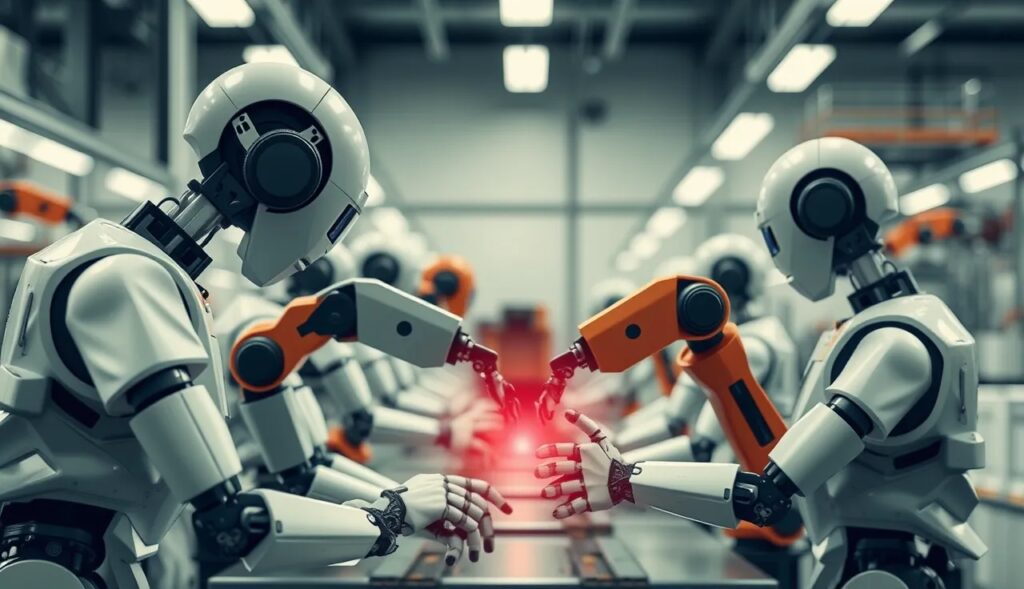
Overcoming Barriers to Trust in Cobots
Building trust in collaborative robots isn’t automatic—it requires addressing specific fears and uncertainties. Identifying these barriers is the first step toward fostering acceptance and confidence.
Fear of Job Replacement
One of the most common fears is that cobots will replace human workers. While automation can shift job responsibilities, cobots often enhance roles rather than eliminate them.
- Cobots handle repetitive or dangerous tasks, allowing humans to focus on creativity and problem-solving.
- Companies that emphasize upskilling and training alongside cobot deployment see higher acceptance rates among employees.
Skepticism About Safety
Despite rigorous safety standards, some workers worry cobots could malfunction or cause harm. This concern is especially common in industries where heavy machinery is prevalent.
- Highlighting cobot safety features like force-limiting sensors and automatic shutdowns can alleviate fears.
- Regular safety drills and demonstrations build confidence in the cobot’s reliability.
Distrust in Technology’s Learning Curve
The perception that cobots are difficult to use can deter adoption. If workers feel the technology is overly complex, trust in its efficiency wanes.
- Clear, hands-on training sessions can demystify cobot operations.
- User-friendly software with visual aids and tutorials ensures even non-technical workers feel capable.
Building Trust Through Real-World Applications
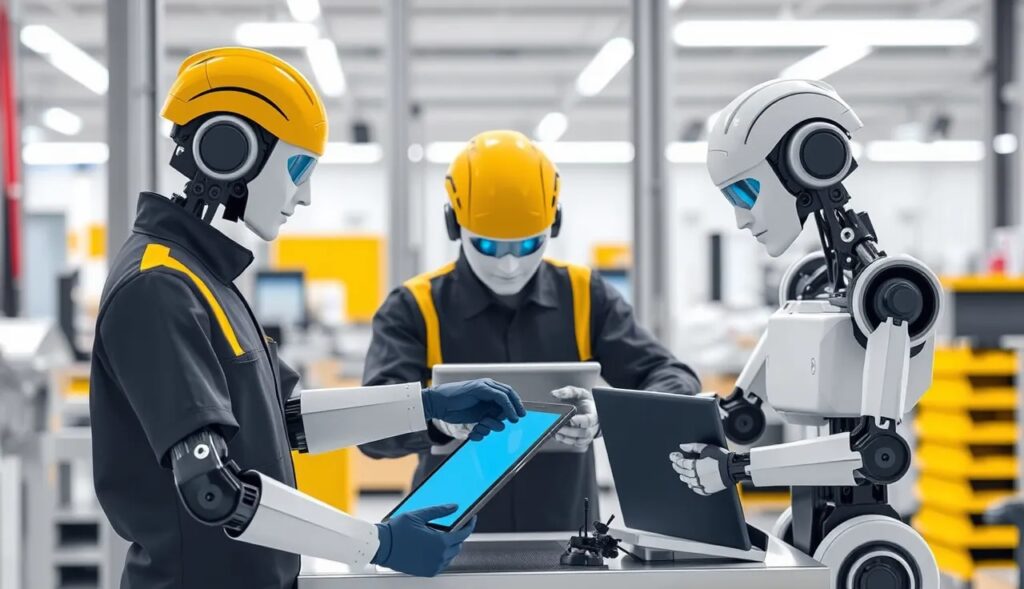
Cobots in Manufacturing
In manufacturing, cobots assist with precision tasks like assembly and inspection. They excel at repetitive processes while maintaining consistent quality.
- Example: A cobot performing welding in automotive production reduces human exposure to heat and fumes while improving weld accuracy.
Healthcare Trust with Surgical Assistance
In healthcare, cobots like robotic arms enhance surgical precision and reduce fatigue for surgeons. Trust in this context grows with successful patient outcomes and transparent data on cobot accuracy.
- Studies published in medical journals highlighting success rates help bridge the trust gap for healthcare professionals.
Retail Fulfillment and Personalized Interaction
Retail operations use cobots for packing and sorting. Some also interact directly with customers, like guiding them to a product.
- Example: Cobots in Amazon warehouses handle sorting while workers focus on customer experience—showcasing teamwork between humans and machines.
The Psychology of Long-Term Trust Maintenance
Continuous Monitoring and Feedback Loops
Cobots must prove their reliability over time. Regular feedback and performance assessments maintain confidence.
- Implementing dashboards that show cobot productivity and uptime can reassure workers and managers alike.
Evolution with User Needs
Cobots should grow alongside their teams. When software updates or new features are added based on worker feedback, trust deepens.
- Example: A cobot that learns to assist with new tools as a factory evolves demonstrates adaptability, ensuring it remains relevant and trusted.
Celebrating Milestones Together
Acknowledging moments where cobots improve safety or productivity reinforces their role as teammates. Recognition fosters positive sentiment.
- A cobot reaching a 1,000-hour operational milestone without errors? Celebrate it with the team!
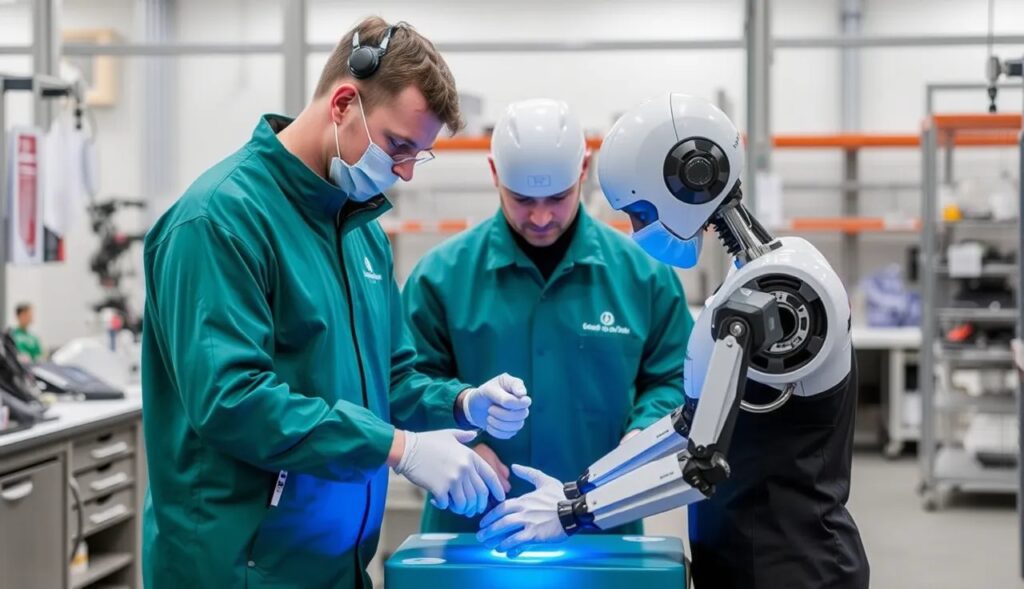
Social and Cultural Influences on Cobot Trust
Regional Attitudes Toward Automation
Different cultures view cobots through unique lenses. In tech-forward regions, trust may come naturally, while others require more reassurance.
- Tailoring cobot introduction strategies to regional norms helps avoid resistance and builds localized trust.
Generational Differences in Acceptance
Younger workers may adapt to cobots more quickly due to familiarity with technology. Older workers, on the other hand, may need additional reassurance.
- Offering mentorship programs where tech-savvy employees support others bridges generational gaps in cobot trust.
Future-Proofing Trust in Cobots
As collaborative robots (cobots) evolve, maintaining trust requires forward-thinking strategies. It’s not just about addressing current concerns—it’s about anticipating future needs and building a long-lasting partnership between humans and machines.
Integrating AI for Smarter Collaboration
Cobots powered by artificial intelligence can adapt to human behaviors and learn from their surroundings. This boosts efficiency and builds trust.
- AI allows cobots to predict worker needs, like adjusting grip strength for fragile materials without prompting.
- The key? Ensure AI-driven decisions are transparent and easy to understand. Clear explanations of cobot logic foster confidence.
Personalization to Individual Workflows
Customizing cobots to suit individual preferences enhances trust. Workers feel more connected to machines tailored to their specific needs.
- Example: A cobot that remembers preferred tool setups or adjusts to the user’s pace creates a sense of teamwork.
- Offering interfaces where workers can tweak settings themselves ensures a sense of control.
Robust Support and Troubleshooting
Even the best cobots can encounter issues. Trust hinges on how well these challenges are managed.
- Accessible troubleshooting guides and responsive tech support instill confidence in the technology.
- Predictive maintenance, where cobots flag potential problems before they occur, is a game-changer in trust-building.
Ethical Considerations in Cobot Deployment
Balancing Automation and Human Roles
Trust falters when automation feels exploitative. Ethical cobot use emphasizes enhancement, not displacement, of human roles.
- Transparency about how cobots will impact job responsibilities builds trust from the start.
- Companies must commit to reskilling workers to keep them at the forefront of evolving roles.
Data Privacy and Security
Cobots often rely on data to operate effectively. Ensuring that this data is secure and used ethically is non-negotiable.
- Regular audits of cobot systems for compliance with privacy regulations like GDPR reinforce trust in sensitive environments.
- Workers should be informed about what data is collected and how it’s used, ensuring no sense of intrusion.
Inclusivity in Design
Cobots should accommodate diverse user needs, from physical disabilities to language barriers. Inclusive design fosters trust by ensuring that everyone can work with cobots effectively.
- Cobots with multilingual interfaces or voice recognition capabilities enhance accessibility.
- Ergonomic designs ensure that cobots fit into diverse workplaces seamlessly.
The Path to Ubiquitous Cobot Trust
Education as a Trust Catalyst
Knowledge empowers. Workers trained on cobot functionalities are more likely to trust and embrace their use.
- Regular workshops, on-the-job training, and even gamified learning modules make training engaging and effective.
Showcasing Success Stories
Real-world examples of cobot integration reassure hesitant workers and managers. Highlighting improvements in productivity, safety, and job satisfaction emphasizes cobots’ value.
- Case studies showcasing cobots’ role in disaster recovery or other critical tasks can inspire trust on a large scale.
Setting a New Standard for Human-Machine Harmony
As cobots continue to redefine workplaces, trust will be the foundation of their success. By combining psychological principles with cutting-edge technology, businesses can create environments where cobots aren’t just tools—they’re partners.
And that’s the blueprint for fostering trust in cobots! Ready to explore how this applies to your industry? Let’s dive deeper!
Practical Steps to Build Trust in Your Workplace Cobots
Now that we’ve explored the psychology and technology behind trusting collaborative robots, it’s time to implement strategies that resonate with your workforce. Practical actions can make the difference between skepticism and full acceptance.
Start with Pilot Programs
Instead of deploying cobots at full scale, introduce them through smaller, controlled pilot projects.
- Use pilot programs to show tangible benefits like reduced workload or improved safety.
- Gather feedback from participants to refine cobot behavior before widespread deployment.
Pilot projects also create internal champions—employees who’ve had positive experiences and can advocate for the technology.
Open Channels of Communication
Building trust requires transparency. Keep employees informed about the cobot’s purpose, capabilities, and limitations.
- Host Q&A sessions where workers can voice concerns and receive direct answers from engineers or managers.
- Share metrics that demonstrate cobots’ value, such as improved quality checks or faster task completion.
Clear communication reduces fear of the unknown and positions cobots as allies rather than threats.
Co-Create Solutions with Employees
Involve workers in the customization and implementation of cobots. When employees feel ownership, trust grows naturally.
- Invite teams to suggest tasks where cobots could provide the most value.
- Offer opportunities for workers to personalize cobot settings to fit their needs and workflows.
This collaborative approach transforms cobots into tools that complement, rather than disrupt, daily operations.
Measuring Trust: Metrics for Success
How do you know if trust in cobots is improving? Monitoring specific metrics can provide insights:
- Employee Sentiment Surveys: Regular surveys gauge how comfortable workers feel about working with cobots.
- Task Efficiency Data: If cobots streamline processes without errors, confidence in their reliability grows.
- Incident Reports: A decline in safety incidents involving cobots indicates increasing trust in their safety mechanisms.
These metrics not only track progress but also highlight areas for improvement.
Continuous Improvement Through Feedback
Trust isn’t static—it requires ongoing effort. Regularly solicit and act on employee feedback about cobot interactions.
- Implement suggestion boxes or digital forms where workers can report issues or share ideas.
- Highlight changes made based on employee input to show their voices matter.
This iterative process keeps cobots aligned with user needs and reinforces trust over time.
The Future of Trust in Cobots
As automation continues to evolve, trust will remain a cornerstone of successful human-cobot collaboration. By blending psychological insights with cutting-edge technology, businesses can ensure cobots are not just tools but valued partners in innovation.
Are you ready to bring cobots into your workplace? With the right strategies, the future looks collaborative and bright!
FAQs
Can cobots work alongside untrained workers?
Yes, cobots are intuitive and often require minimal training to operate. Many come equipped with drag-and-drop programming or user-friendly interfaces that allow anyone to assign tasks quickly.
For example, in a warehouse, an employee with no coding experience can guide a cobot to sort packages by simply moving its arm to demonstrate the task. Over time, cobots “learn” routines, further reducing the need for technical expertise.
What happens if a cobot malfunctions?
Modern cobots are equipped with self-diagnostic tools that flag issues before they escalate. If a malfunction occurs, the cobot will often shut down automatically to avoid causing harm.
For example, in assembly lines, if a cobot detects a calibration issue, it may pause its operation and display a warning for technicians to address. Regular maintenance schedules also minimize the chances of such malfunctions.
Will cobots replace human jobs?
Cobots are designed to augment human roles, not replace them. They take on monotonous or physically demanding tasks, freeing employees to focus on strategic, creative, or decision-making responsibilities.
Consider healthcare: a cobot might assist in sorting medications in a pharmacy, allowing pharmacists to concentrate on patient consultations. This collaboration enhances productivity and improves job satisfaction without eliminating roles.
How do companies ensure cobots are reliable over time?
Reliability comes from regular updates, maintenance, and quality assurance testing. Most cobots are connected to cloud platforms for remote monitoring and diagnostics, ensuring they remain efficient.
For example, in logistics, a cobot might receive software updates to adapt to new package sizes or delivery speeds, maintaining its relevance as operations evolve.
Are cobots adaptable to different industries?
Absolutely! Cobots are versatile and used in sectors ranging from manufacturing and healthcare to retail and hospitality.
In food production, cobots can handle delicate ingredients like eggs without breaking them. In retail, they assist with inventory tracking by scanning barcodes on shelves. Their adaptability makes them a valuable asset across varied industries.
How can businesses overcome resistance to cobots?
The key to overcoming resistance is education and transparency. Engaging employees early in the process and providing clear benefits builds acceptance.
For example, companies can host workshops to showcase how cobots reduce workload or improve safety. Additionally, sharing success stories from similar industries helps dispel myths about job displacement or complexity.
Do cobots require significant infrastructure changes?
Not necessarily. Cobots are designed to integrate into existing workflows with minimal disruption. They’re compact, lightweight, and often mobile, making them ideal for workplaces without the need for extensive reconfiguration.
For instance, a cobot on wheels can move between production lines in a factory, handling different tasks as needed without requiring new machinery or layouts.
Can cobots handle creative or complex tasks?
While cobots excel at repetitive and precision-based tasks, they can assist with creative processes too, provided they’re programmed appropriately.
For example, in product design, cobots might handle rapid prototyping by 3D printing components, enabling designers to focus on refining aesthetics or functionality. They’re collaborators, not creators, when it comes to complex or imaginative tasks.
How do cobots ensure data security?
Cobots rely on secure systems to prevent unauthorized access or data breaches. Most cobots are integrated with encrypted networks, protecting sensitive operational or personal data.
For example, in a medical setting, cobots assisting with patient data entry ensure compliance with privacy regulations like HIPAA by encrypting all transmitted information. Regular audits and software updates bolster their security further.
Are cobots environmentally sustainable?
Yes, cobots are typically more energy-efficient than traditional machinery. They’re designed to consume less power and reduce waste by improving precision and minimizing errors.
For example, in electronics manufacturing, cobots can solder components with exactness, reducing material waste compared to manual or less efficient automated systems. This precision directly contributes to sustainability goals.
How quickly can a business see ROI from cobots?
Return on investment (ROI) depends on the industry and application, but many businesses see benefits within months of implementation. Cobots reduce operational costs, enhance productivity, and minimize downtime.
For instance, a small packaging business might deploy a cobot for box assembly. Within six months, the company saves on labor costs and speeds up production enough to recover its investment.
Can cobots be used in small businesses?
Absolutely! Cobots are ideal for small and medium-sized enterprises (SMEs) because of their affordability, flexibility, and ease of use. Unlike large industrial robots, cobots don’t require extensive setup or maintenance.
For example, a boutique bakery might use a cobot to decorate cakes consistently and efficiently, freeing up bakers for more intricate creations. This allows small businesses to compete with larger competitors.
How do cobots handle real-time decision-making?
Advanced cobots are equipped with sensors and AI algorithms that enable real-time decision-making. They can adjust to dynamic environments, such as recognizing obstacles and re-routing their tasks accordingly.
For example, in logistics, a cobot carrying items might detect a blocked path and autonomously choose an alternate route to complete its delivery. This adaptability is key to seamless collaboration.
Do cobots require constant supervision?
No, cobots are designed to operate autonomously once programmed. However, they provide real-time feedback and alerts to keep human operators informed when intervention is necessary.
For instance, a cobot running a quality control check on a production line will notify the operator only if it detects an anomaly, ensuring minimal disruption to workflows.
How do cobots handle precision tasks?
Cobots are engineered for high precision, using advanced sensors and machine vision systems to achieve accuracy. They’re especially valuable in industries requiring meticulous detail.
For example, in the jewelry industry, cobots can polish gemstones with micrometer-level precision, ensuring consistency and quality that’s hard to match manually.
Are cobots capable of multitasking?
Yes, many cobots can handle multiple tasks either sequentially or simultaneously, depending on their programming and tools. This makes them invaluable in fast-paced environments.
For example, in a car assembly line, a cobot might alternate between welding parts and applying adhesives, streamlining processes without compromising accuracy.
What’s the lifespan of a typical cobot?
Cobots are built for longevity and can operate reliably for years with proper maintenance. Their lifespan often depends on usage intensity and adherence to maintenance schedules.
For example, a cobot used eight hours a day in a manufacturing plant might have a lifespan of 5-10 years, with periodic software updates and part replacements extending its usability further.
Can cobots work in teams with other cobots?
Yes, cobots are often programmed to collaborate with other cobots or robots, forming synchronized systems. This teamwork enhances efficiency and productivity in complex workflows.
For example, in e-commerce fulfillment centers, one cobot might handle picking items while another manages packing, ensuring seamless transitions and faster output.
Resources
Research and White Papers
- “Trust in Automation: Designing for Success” by MIT Sloan Management Review
Explores how human trust in automation evolves and offers practical strategies to foster better collaboration. Read it here. - International Federation of Robotics (IFR)
Offers comprehensive insights into robotics trends, including cobot adoption and trust-building approaches. Visit IFR for reports and case studies.
Industry Standards and Safety Guidelines
- ISO 10218: Industrial Robot Safety Standards
Details global safety requirements for collaborative robots to ensure seamless human-machine interaction. Learn more at ISO Standards. - Robotics Industries Association (RIA)
Provides safety guidelines specific to collaborative robots, including deployment and risk assessment tools. Explore their resources.
Training and Certification Programs
- Universal Robots Academy
A free online platform offering cobot programming tutorials and safety training. It’s ideal for beginners and advanced users alike. Access the platform at Universal Robots Academy. - FANUC Robotics Training
Hands-on courses covering cobot integration, operation, and troubleshooting for various industries. Learn more.
Case Studies and Success Stories
- ABB Robotics Use Cases
Explore real-world examples of cobot integration in industries like manufacturing, healthcare, and logistics. Visit ABB Robotics. - KUKA Robotics Case Studies
Highlights how cobots enhance productivity and foster trust through innovative design and applications. Visit KUKA.
Online Communities and Forums
- Robot Operating System (ROS) Community
A collaborative space where developers and engineers share insights on programming and optimizing cobots. Join discussions at ROS Community. - Reddit: r/Robotics
Engage with a wide community of robotics enthusiasts, professionals, and researchers to discuss cobot technology and trust-building techniques. Visit r/Robotics.